
All photos courtesy of Derek Brad
The Legend of Zelda hit its 25th anniversary in 2011. To celebrate, the first three “Symphony of the Goddesses” concerts were performed: one in LA, one in London, and one in Tokyo.
In 2012, “Symphony of the Goddesses” has been expanded in terms of content and gone on a North American tour. Recently, OSV contributor Haroon Piracha gave his impression of the E3 2012 show in LA, and he also conducted an interview with SotG’s music arranger, Chad Seiter.
On Wednesday, July 25 2012, I finally got to witness for myself the concert about which Haroon and others had been cheering for. Better still, I got to take my wife with me to make it a (very rare) evening without the kids, and we also got the opportunity to speak with the concert’s creative lead / producer, Jeron Moore.
After the jump, I’m going to tell you the story behind the story. How it all got started, what it means to work with this creative team, possible plans for the future, as well as my own impressions of the show interspersed. Get ready, it’s going to be a wild ride.
If Link is “The Hero of Time,” then the people behind “Symphony of the Goddesses” are the heroes of timing: of punctuality, of synchronization, of fortuitous sequences of events. Chief among these people is Jeron Moore, the creative lead behind the SotG project.
Unfortunately, time is a precious commodity when you’re working under a tight schedule. My wife and I arrived at the Mann Center in Philadelphia promptly at 3pm, one hour before the dress rehearsal began. I make a call to Jeron, only to find out that he’s running. A heat wave through Philadelphia, and Jeron’s running on a Wednesday afternoon before the show. I shouldn’t be surprised: the Dallas native doesn’t fear the hot weather. The point is, dress rehearsal was starting in under an hour, and this guy does a 5k in his spare time. Talk about motivation.
Upon Moore’s return, we get a guided tour of the Mann Center’s backstage area. Most of it is what you’d expect: dressing rooms, a loading dock (the Pittsburgh Symphony Orchestra came to Philadelphia for this show, and all their equipment is unpacked around the back), a dining area, a security checkpoint, and — at one wing of the stage — a makeshift control room with half a dozen high-end computers set up, each being manned by someone from JMP Productions.
This last part is important to be thinking about. You see, for all the touring game music concerts out there, I think it’s safe to say that none is as tech savvy as “Symphony of the Goddesses.” Yes, almost all of them have video footage with the audio, and yes, some of those videos are designed to sync with the orchestra (which requires the conductor, if not the whole orchestra, listening to a click-track). But no one’s done it to the level of SotG.
As the rehearsal started, I watched as conductor Eímear Noone explained the nature of the show to the Pittsburgh Symphony Orchestra (and the backing choir, which was from the Philadelphia location). The men and women of the Pittsburgh Symphony were largely agreeable to Ms. Noone’s request that everyone wear a single earbud in one ear that would play the click track in sync with what the conductor heard and what the guys backstage running the video heard. From my vantage point, I’d say at least 80% of the orchestra took advantage of these individualized devices. One stodgy old man, whom I believe was in the trombone section, raised his hand and said “yeah, I don’t play to a click-track.” Eímear assured him that that was fine, and to just follow the tempo per her conducting in that case.
Really, she handled it like a pro. If there’s one thing I can say about Ms. Noone, it’s that she simply radiates charm and charisma. If she had instructed the audience to run into oncoming traffic, I daresay a few people would have done it just because she has that way about her. Fortunately for all of us, Eímear Noone only uses her superpowers for good.
Now, I know playing to a click-track isn’t exactly something hardcore orchestral fans get excited about. I myself would happily do without it, and I know many within the OSV ranks that don’t appreciate live orchestral performances set to a click-track. So I decided to start with by airing this grievance, as a sort of hypothetical “does this diminish the art of orchestra?” to producer Jeron Moore. It was a rocky way to start out an interview, but I was glad I asked.
Here’s how I phrased my question: “With a set click-track, you lose the sort of artistic license and freedom to have staggered tempo and rubato with the orchestra. Couldn’t this diminish the artistic value of the music?”
Jeron’s response: “Look, there’s an art to doing orchestra that way. But what we’re doing is extremely similar to a scoring session, where timing must be exact. And the ability to do that, to synchronize audio and video, is an art form in and of itself. The ability to take that scoring session, then, and perform it live, takes the art form of music score to another level entirely.”
Considering the concert isn’t just audio, but is something akin to a scoring session, the story being re-told through footage of the game requires a keen eye and expert knowledge of the franchise. Being both a Zelda fan and a (now-graduated) student of film production, Jeron Moore is perfectly positioned to bring together the footage. I asked him how he put it all together: how many playthroughs did it take? Were you using your own capturing equipment? His answer surprised me.
Essentially, long before Nintendo gave the green light, Jeron and Chad built their proof of concept out of less-refined material. “I know the games backwards and forwards […] I’ve been training for this since I was five. What I did was turn to the community for help. YouTube “Let’s Play” videos, from Chuggaaconroy and all those guys, had the footage I was looking for. They were a huge help.”
Jeron then explained to me about getting the footage “perfect.” I thought he was referring to cutting lines of dialogue out of cut scenes, but no: he was referring to the gameplay, particularly boss battles. “We put together the sort of ideal playthrough; I couldn’t get that entirely out of the ‘Let’s Play’ videos. Once Nintendo approved the project, I’d send them my edited YouTube videos, and then Nintendo would go through and get fresh captures […] pristine-quality videos with just the right action sequences. It was painstakingly done by our team and Nintendo’s team. What they [Nintendo] would send me wouldn’t always be perfect, so sometimes I’d have to send it back and ask for more edits. But this process was far more efficient than me attempting to capture my own footage.”
The proof-of-concept Jeron built in video form was accompanied by Chad’s arrangement, but in MIDI form. “It’s kind of like making a music video. What we were doing, in the industry, is called ‘music spotting.’ Chad and I would watch the videos I’d put together, and we’d consider the moods and the moments and build the arrangement based on the story presented in the video.”
It was such a surreal experience, talking to Jeron below the stage where the orchestra was doing their final rehearsal before the show. I’d hear the music he was referring to, then walk by a computer monitor and see the footage playing with the music. I knew that we were in for a treat that evening.
Now, I think Haroon spelled out what made the four-movement “Symphony of the Goddesses” proper so great. The other thing that’s so great about this show, then, is that it’s packed full of music. The four movements: Ocarina of Time, Wind Waker, Twilight Princess, and A Link to the Past — these are the feature presentation of the show. But there are breaks within those movements, and there are other arrangements serving as book-ends for the four-movement feature.
The show didn’t begin until 8:30pm. The Mann Center, an outdoor venue, was packed with people (the total number reported was just shy of seven thousand). We were in the cool of the evening, the sun had set, and crickets were chirping. Then, out walks Ms. Noone, confident and charming as can be, and the orchestra plays an overture that hits several key themes, and the video screen shows a montage of scenes from a variety of Zelda games. After the overture, a longer “Dungeon” medley was presented, which primarily featured the older, 2D Zelda titles. I was very pleased to hear and see both Link’s Awakening and Zelda II: Link’s Adventure in this medley. The music, while not being showy or technically complex, highlighted the strength of the melodies and offered loads of support from different instrumentalists. More on the instrumentation later.
There were two more “medley” pieces before the main event. A “Kakariko Village” medley showed off the village as it appeared in LttP, OoT and TP. Because the song has maintained its melodic motif throughout all those games, it allowed Chad Seiter to elaborate and build variations as we saw Link interacting with the townspeople (and chickens) of Hyrule’s best-known town. After that, a special OoT-specific medley, “Songs of the Hero,” was introduced. This one didn’t have any video footage, which allowed the audience to really soak in the power of the orchestra. These “songs” were the various melodies Link played on the Ocarina: Sun’s Song, Song of Time, Serenade of Water, Song of Healing, Song of Storms, and then closing with a giant intricate swirl of all the various melodies, as if taken away by a giant tornado. Fleshing out what were, essentially, little jingles into a full orchestra is really special. I will say, though, I was surprised that “open the treasure chest” jingle wasn’t used as a musical joke anywhere throughout the evening.
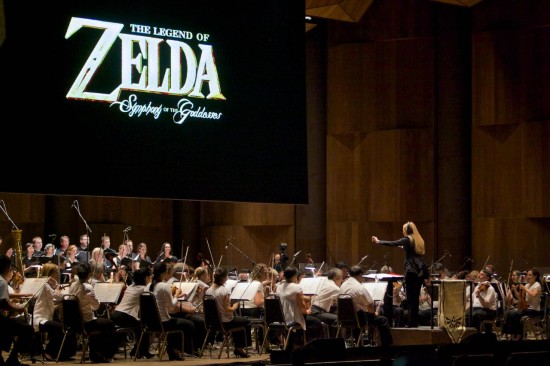
[Pittsburgh’s finest musicians come to the city of brotherly love to celebrate the hero of time. More at 11.]
The four-movement symphony then began. It opens with a special “Song of Creation” feature, which shows almost in its entirety the story of Hyrule’s origin as presented in OoT: the three goddesses come, create the land and people of Hyrule, and then disappear, leaving the Triforce behind. As the four-movement SotG actually follows the Zelda timeline (taking into account Hyrule Historia’s split/”alternate universe” timeline — WW in the “child” line, TP in the “adult” line, and LttP in the “Hero of Time fails or never exists so Ganondorf gets his way” line), it makes sense that the story would open with the creation of the world. Here we find: Din, the red goddess of power; Nayru, the blue goddess of wisdom; Farore, the green goddess of courage. So many archetypes are established here, and considering the show is named after these three female deities, it’s important to establish them as the starting point. Musically, this is one of the most epic and chilling points of the show. It ends on a dissonant trill, too, which is a very interesting choice.
Between the second and third movements, just after the intermission, the orchestra and choir performed a special live version of the Fountain Song, one which actually differs from the version released on the 25th anniversary / Skyward Sword bonus disc (which was also arranged and recorded by Chad, Eímear, Jeron and team). Haroon mentioned in his interview with Chad the power of the French Horn (Chad said: “We would’ve had eight, but for budgetary reasons we have six; most orchestras get by with four!”). Even more exciting to me was that this show calls for not one, but two harps. And instead of throwing them off to the side of the stage, they are front and center, easy for the audience (and the video cameras) to spot. These harpists aren’t just playing random glissandos to enhance a given moment. Long, melodic strains come from these beautiful instruments, thanks both to Koji Kondo for using them in so many games, and to Chad for realizing that the Fountain Song would be best performed with two harps instead of one. Wow: it was fantastic.
After the four-part symphony concluded, Jeron Moore teased the audience with a carrot-and-string *triple encore.* Haroon hinted at what was performed here but didn’t want to spoil it. I’m going to spoil it for you; not just because I want to talk about them, but because the lineup for this encore may change in the coming months as Jeron and Chad work on more material. I’m recording this information for posterity, you see.
The first encore piece was “Ballad of the Wind Fish” from Link’s Awakening. This was easily my favorite piece from the entire evening. Go look up the source tune in case you forgot it. Hint: it’s really, really good. It makes me wish Nintendo did something huge with this Game Boy title. Jeron chose not to put together any video footage for this one; so, like the “Songs of the Hero” medley, we saw the orchestra and nothing else. It was a great moment to reflect. I asked Jeron after the show if perhaps he’d considered featuring concept art on the large screen during this, and he told me it had been considered (for this and many other games), but that Nintendo tends to “keep that stuff vaulted pretty tightly.” They don’t reveal what all is in their catalogue of assets, so you can’t just say: “what do you have for Link’s Awakening?” Instead, you have to request specific assets, as if you already knew what was in the vault, and hope that a) it exists, and b) Nintendo is willing to release it. It’s a guessing-game that’s really not worth playing.
The second encore, certainly a fan favorite: “Gerudo Valley.” Jeron said “This one is dedicated to all the ladies out there.” The video footage reminds you as to why, if you haven’t played Ocarina of Time in awhile. It’s a town of all-female warriors who give Link a truly difficult time before finally accepting him as a worthy warrior, despite his maleness. This arrangement was, I dare say, the weakest of the bunch. I love this song like crazy, but without the acoustic guitar, it just isn’t right. The trumpets were a little lackluster as well, and I best remember the violins and the pitched percussion (xylophone and marimba) doing the song’s strong melody some justice.
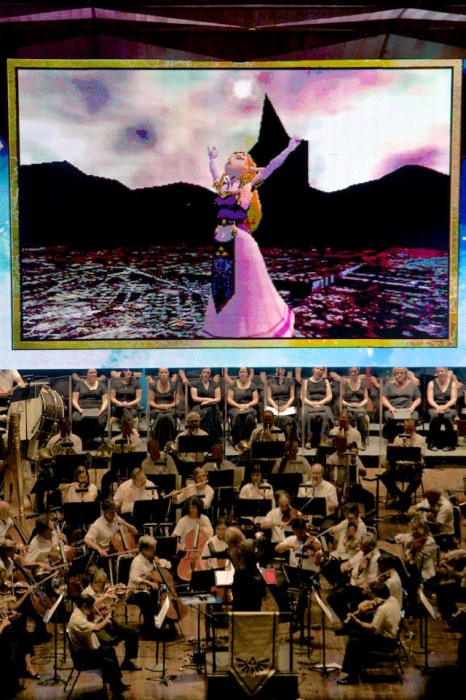
[Zelda may not be the militant feminist the women of Gerudo would like her to be, but she is certainly strong-willed.]
And, finally, encore number three, was a full medley for Majora’s Mask. Apparently, this was something many fans were clamoring for in 2011, and they didn’t have anything prepared. So Jeron and Chad prepared something, and it really is something special. My memories of the game are, personally, rather faint. But this medley brought it all back. It almost felt like a fifth movement of the symphony (though Jeron told me, if they build onto the symphony proper, it would be an “act zero” putting Skyward Sword at the opening, appropriately placed in the timeline).
I needed some time after the show to gather my thoughts and recover. Time, what a precious commodity. I asked my wife about her ability to appreciate the show as an orchestra fan but not so much a Zelda fan (she’s only slightly acquainted with the franchise). Her statement: “it was certainly lovely, and I feel like I know the stories of Zelda, Link and Ganon much better just by watching this concert.” Indeed.
While I recovered, Jeron didn’t recover. He drove through the night to the next venue (Vienna, VA’s Wolf Trap, near Washington DC) and actually did tech setup with his crew between 2am and 5am. They performed there Thursday night, then went to Pittsburgh to perform (again with the Pittsburgh Symphony Orchestra) two nights in a row at an indoor venue (the Heinz Hall) which seated about 2500 and was near sold-out both nights. So, between Wednesday and Saturday of this past week, 18,000 people saw the show (the Wolf Trap venue had about 6000 attendees). I got to talk to Jeron on the phone after this whirlwind segment of the tour to gain some more feedback and insight.
Given the hectic schedule, I asked Jeron if he felt like a rock star on tour. “No, not quite a rockstar. I’m nervous every night, at the start of every show, but we find a way to have fun.” He even hinted to me that sometimes, he needed to give the audience permission to have fun. The Philadelphia crowd didn’t need any help with that, but at the indoor venue in Pittsburgh, Jeron admitted he had to rile the audience up a bit at the beginning so that they could relax their shoulders and cheer at the times they felt like cheering.
Jeron also reiterated what a privilege it was to be doing this. Even when he feels burnt out, he keeps going. “I remember how my passion and excitement [for the franchise] reignited something in Chad when he first went to work on the music. That same passion, coming from the fans, reignites my love of Zelda.”
I asked Jeron to brainstorm with me: with the continued success of this show (now halfway through its 2012 season, picking back up in September in Toronto), if he could have his wish granted (by the Triforce or some other entity), what would he do next? “Lots of things! I’m very close with Jeremy Soule; I even helped him put together and release the soundtracks for Morrowind and Oblivion. So, if there were demand for it, I’d love to do a show just for The Elder Scrolls series. […] I’d love to work with Nintendo on more of their franchises as well.” When asked to clarify on that point, and whether or not this meant live concerts or recorded albums, Moore informed me that there are concerns in the realm of music ownership and other legal issues that make any published recording very difficult to do. “We’re working closely with Nintendo,” he said after I suggested a CD or a Bluray/DVD release of SotG. “But no guarantees!”
In looking over all things Zelda in preparation for the show, I remembered re-learning something I’d nearly forgotten: A Link to the Past is a completely fabricated subtitle by Nintendo of America. The original subtitle in Japan is Kamigami no Triforce (or: “Triforce of the Gods”). Given that this could be rendered as “Triforce of the Goddesses” after the story was fleshed out further in OoT (you’d have to change “kami” to “megami,” but you get the idea), I asked Jeron if the name of the show was meant to be patterned after LttP’s original subtitle. “No, that was the original title. I knew it from the day I pitched my idea to Chad, that was the title. And, in fact, Nintendo didn’t like this title at first, but they eventually warmed up to it.” Jeron went on to emphasize the creation myth presented in OoT, and then talked about the cyclical nature of the Zelda games, and how that compares to ancient Greek mythology, or more recently, the TV series Battlestar Galactica: “All that has happened before will happen again.”
Being at the halfway point of the 2012 tour, I also thought it appropriate for Jeron to think back over the shows performed so far and comment on some of his favorite venues, and speculate on which he’ll enjoy the most in the future. “The 2012 launch show was in Dallas, my hometown. My extended family, my old high school buddies, even some of my music teachers were there. So that had a lot of sentimental value.” Any others? “Philadelphia had a great fanbase, for sure! I also loved going up to Canada! We’ve played in Vancouver and Montreal so far, and I just loved being in those cities. Later we’ll be going to Calgary and Toronto, and I’m also looking forward to that.” Other cities he’s looking forward to visiting include New York City, Boston, and Chicago.
One final question, and this is one that I fished out from the Mann Center audience on Wednesday night: “If you, Chad and Eímear were forced to cosplay for an evening, whom do you imagine each of you dressing up as?” Considering all the cosplayers that show up to these shows, I thought this was an easy question. But Jeron was a little thrown off by it! He admitted that it’s something he’s never done, but the prospect of it interests him. To answer the question, he had this to say…
Regarding Eímear: “I think the obvious choice is Zelda herself, but the costume would have to be very tastefully done.”
For Chad: “He’s going to hate me for saying this, but my sense of humor leads me to say ‘Tingle.'”
And for himself: “I might be too tall for it, but obviously I’d love to be Link. As for the ‘style’ of Link, it would have to be as he appears in Twilight Princess, which is my favorite game in the franchise and really presents a mature, adult version of Link. Also, he’s probably the tallest Link, which is important.”
Before I hung up the phone, Jeron mentioned that there may be room for Symphony of the Goddesses to go on a “second season” tour in 2013 or beyond. It would certainly revisit some material from the first season, but there’s plenty of other stuff they’d love to cover, from different games and also whole motifs from the four “main” games they selected that they haven’t explored yet musically. So, it’s something to be on the lookout for.
I have to say that I generally have a great time at every VGM concert I attend, be it rock, chiptune, or orchestra. There’s so much great stuff out there these days, I feel like a kid in a candy store. Comparing “Symphony of the Goddesses” to other shows I’ve seen, I’ll first of all say that it’s easily the most cohesive show, as it focuses on a single franchise, and that franchise has stayed remarkably consistent in its characters and themes (as opposed to, say, Final Fantasy, which is a different universe in each entry). There weren’t any flashy solos or parts of the music that I found to be particularly difficult for a given section or for the full orchestra, but I thought this show has a sense of *timing* (there’s that word again) that I’ve not seen anywhere else. It really is something special.
So, whether you’ve remained an ardent fan of the Zelda franchise, or maybe you’re like me and you haven’t been following it as closely in the last few years, you’ll find that passion for a truly special part of gaming history coming back to life if you attend this show. Be sure to check out the schedule for the rest of the 2012 tour’s location and dates. Also, for more insight about the show from Jeron’s perspective, be sure to check out the interview he did with the Nintendo World Report last month.
Tags: Chad Seiter, Community Question, Concert Report, Eimear Noone, Gerudo Valley, Interviews, Jeron Moore, JMP Productions, Link to the Past, Live Event, Majora's Mask, Ocarina of Time, Philadelphia, Symphony of the Goddesses, The Legend of Zelda, The Mann Center, Triforce, Twilight Princess, Wind Fish, Wind Waker





























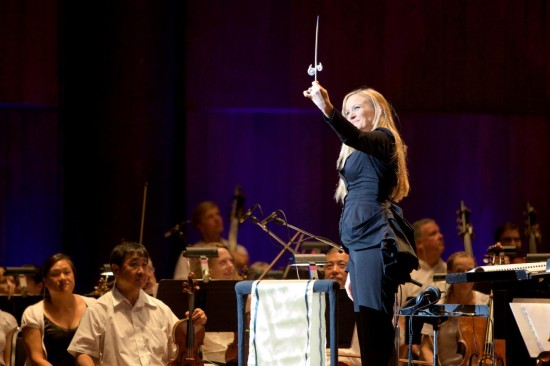
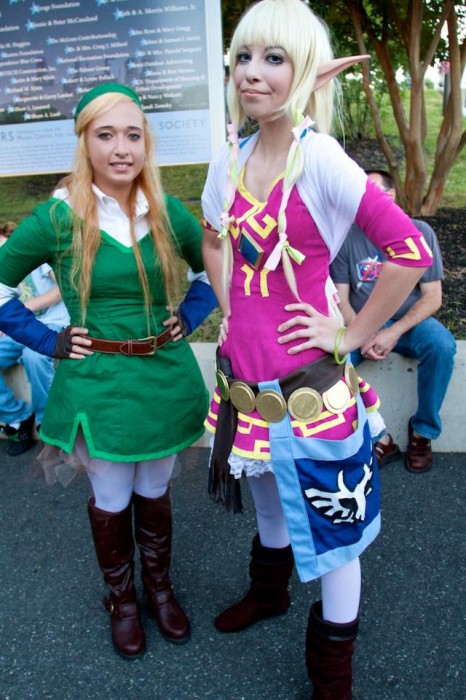
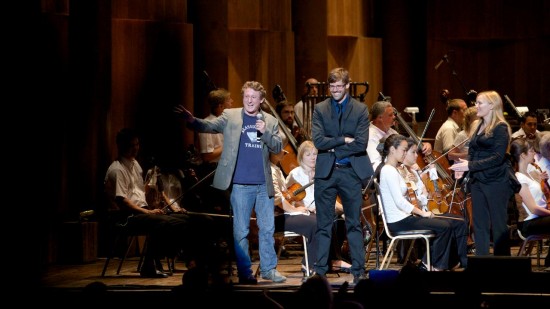
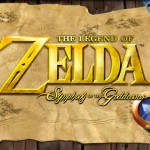
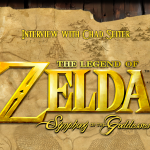









Thanks Patrick, that’s one of the smartest and most observant articles I’ve seen. Our entire team – aside from Jeron, Chad and I there’s our excellent production, music and tech colleagues – is so passionate about the project and I’m so glad that it shines through. From my point of view you can get more inside info on the orchestras and performances on my blog: View From The Podium, Zelda Conductor Eímear Noone,
Very Best Wishes,
Eímear xo
Wish I had been there! Since I probably won’t get a chance I really hope they release a BluRay/DVD/Download of the concert. It would sell super well and more importantly would allow so many more fans to share in the experience.
This concert sounds fantastic! I really hope they continue with it in 2013. Of course I hope they come to Europe, but spreading VGM beauty anywhere in the world simply warms my heart.
[…] Source: Original Sound Version […]